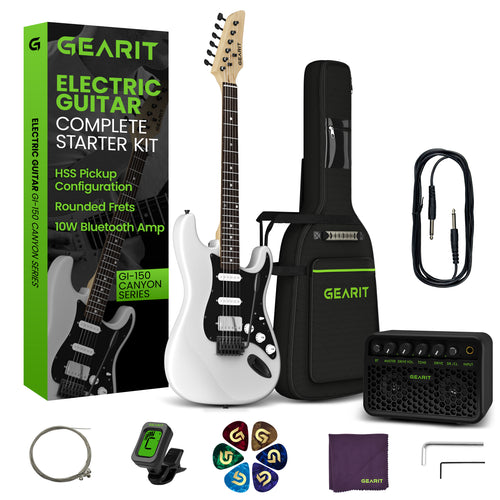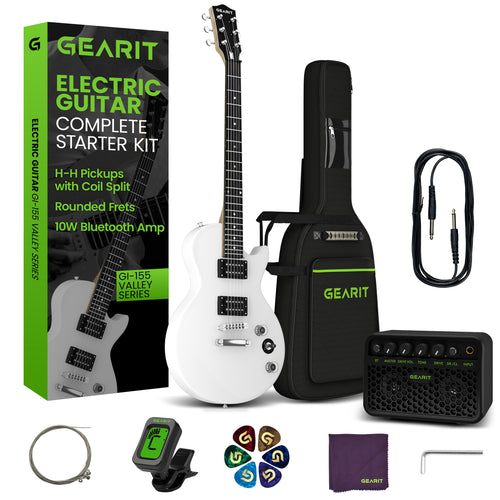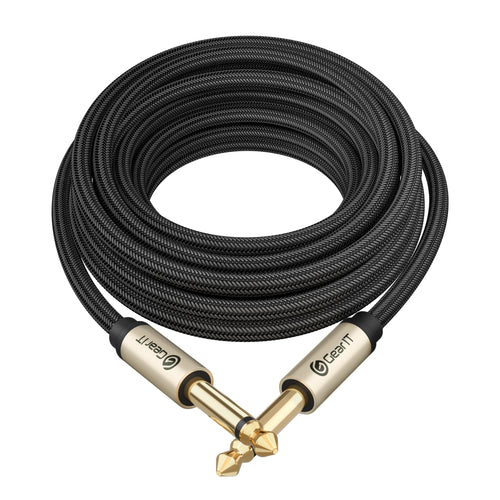
An electric guitar is made up of various parts that work together to create its unique sound and help you play it. Understanding electric guitar parts, like the pickups, body, and neck, is key to getting the sound you want. Each component plays an important role in shaping the tone and feel of your instrument.
The body, neck, and headstock form the basic structure, while the pickups, controls, and output jack define the sound. The strings vibrate and are picked up by the pickups, which send signals to an amplifier, transforming simple vibrations into rich, amplified tones. Elements like the bridge and fretboard also significantly influence how the guitar feels and plays.
Learning about the different parts of an electric guitar can be exciting because it opens up a world of customization. By knowing how each piece contributes to the sound and playability, you can tailor your instrument to suit your style better.
Electric Guitar Parts

1. Body of the Electric Guitar
The body of an electric guitar is more than just a piece of carved wood. It plays a vital role in shaping the sound and providing the guitar's distinct look.
Types of Wood
The type of wood used in the body can greatly influence the tone. Mahogany is known for its warm, full sound. Alder offers a balanced tone with clear highs and lows, while maple provides a bright, snappy sound. Each wood type contributes to the guitar's unique character.

Body Shapes
Electric guitars come in various body shapes. The Stratocaster is famous for its contoured body, which makes it comfortable to play. The Les Paul, on the other hand, has a more solid feel with a single-cutaway design. Different shapes not only affect style but also the way the guitar resonates.
Role in Resonance and Tone
The body contributes to both resonance and tone production. It impacts how vibrations from the strings are amplified. A larger body can enhance bass frequencies, while smaller shapes may focus more on treble. The combination of shape and wood type creates the overall tone you hear.
2. Electric Guitar Neck Parts
When choosing a neck for your guitar, you have several materials to consider for the fretboard. Common options include rosewood, maple, and ebony. Each has its own feel and effect on sound. Rosewood offers a warm tone, maple provides brightness, and ebony is known for its smooth playability.
The number of frets can range widely between guitars, typically from 21 to 24. More frets can give you extra notes to play but might make it harder for your fingers to move quickly due to closer spacing.

Neck shape and scale length also play important roles in how your guitar feels and sounds. The shape of the neck affects grip and comfort in your hand. Common shapes like C, V, or U cater to different playing styles.
The scale length impacts the tension of the strings and tone. Longer scales generally provide brighter tones but require more finger stretching. Shorter scales are easier to play and produce warmer sounds.
3. Pickups: The Heart of Your Guitar’s Sound
Electric guitar pickups are important for shaping your instrument's sound. They capture string vibrations and convert them into electrical signals. These signals are then amplified to produce sound through your speakers.
How do Pickups Work?
Pickups consist of magnets wrapped in copper wire. When the guitar strings vibrate, they change the magnetic field, creating an electric current. This process is known as electromagnetic induction.
Types of Electric Guitar Pickups
-
Single-Coil Pickups: Known for their brightness and clarity, they produce a sharp, crisp sound. They are ideal for genres like blues, country, and rock.
-
Humbucker Pickups: These offer a rich and warm sound, perfect for genres such as jazz, hard rock, and metal. They are designed to reduce noise, such as hum.

Active vs. Passive Pickups
-
Active Pickups: Use a preamp to boost signal strength, providing a more consistent and powerful sound. They require a battery to operate and are often used by heavy metal and hard rock musicians.
-
Passive Pickups: Do not require a battery and offer a more dynamic range. These are popular in a wide variety of music styles, from blues to rock.
Choosing the Right Pickup
Your choice should reflect the music you play. Experiment with different types to discover what works best for your style and sound preferences.
4. Bridge and Tailpiece: Vital for Stability and Sustain
The electric guitar bridge is a key part of your instrument. It secures the strings and influences sound. There are several types of bridges. Fixed bridges offer great tuning stability and sustain because they are firmly attached to the body. They don't allow for pitch bends, which makes them ideal for certain music styles.
On the other hand, tremolo bridges let you change pitch by moving the bridge up or down. This allows for expressive playing and unique sounds. However, they might need frequent tuning. Floyd Rose bridges are a specialized tremolo system known for staying in tune even during extreme pitch bends.

Choosing the right bridge depends on your playing style. If you want stability and sustain, a fixed bridge might be your best option. For more expressive playing and pitch effects, consider a tremolo or Floyd Rose system.
The tailpiece anchors the strings and affects string tension and sustain. A well-chosen tailpiece can enhance your guitar's sound and feel. It’s important to match it with your bridge choice to optimize performance. Whether you aim for stability or flexibility, the right setup can make a big difference in your playing experience.
5. Tuners and Tuning Machines: Key for Staying in Tune
Tuners are important for keeping your electric guitar in tune. They ensure the strings maintain the correct pitch during play. Different types of tuners offer various benefits, making it important to choose the right kind for your style and needs.

Locking Tuners
These are popular among rock and metal players. They provide extra tuning stability, especially when using a tremolo or playing aggressively. Locking tuners minimize string slippage and make restringing simpler.
Vintage-Style Tuners
Known for their classic appearance, they suit those who favor a traditional look and sound. While these might not offer the same stability as locking tuners, many players appreciate the aesthetic and tone.
Choosing the Best Tuners
Your playing style impacts your choice. If you're into heavy bends, locking tuners are beneficial. Vintage tuners are great for those who value classic vibes. Consider your guitar, music style, and preference before deciding.
Maintaining your tuners is also key. Regular cleaning and lubrication can improve their lifespan and performance. By choosing the right tuners and caring for them, you can enhance your instrument's stability and sound.
6. Electric Guitar Electronics: Pots, Switches, and Wiring
In electric guitars, electronics are key to shaping the instrument's tone.
Volume and tone pots
Volume and tone pots, short for potentiometers, adjust the sound. Volume pots control how much of the signal goes to your amplifier. Tone pots adjust the brightness of your sound by modifying how much high frequency is cut.

Pickup selector switches
Pickup selector switches let you choose which pickups are active. These switches can help you quickly find the right sound for different playing styles. By selecting between the neck, middle, and bridge pickups, you can switch from a bright, sharp tone to something warmer or more mellow.
Capacitors
Capacitors play a big role in the tone circuit. They work with tone pots to determine which frequencies are cut. Different capacitors can significantly change your guitar's sound. For example, larger capacitors can produce a warmer tone by cutting more high frequencies.
Wiring is important for connecting all these components. Good wiring ensures that signals are transmitted without interference. It can impact the overall reliability of the electronics, making high-quality wires a sought-after upgrade for many guitarists.
Many players consider upgrades to get better tone control. Common enhancements include installing higher-quality pots, switches, and capacitors. These changes can offer smoother control and more options for shaping your sound, making them a popular choice for improving an electric guitar's performance.
7. Electric Guitar Nut: Small but Significant
The nut on an electric guitar might seem minor, but it plays a vital role. It sits at the top of the neck, holding strings in precise alignment. This spacing is crucial for making each string easy to play.
Proper spacing also ensures that the strings vibrate freely without unwanted buzzing or muted notes. This helps maintain the consistency and clarity of the sound as you play.

Another important function is tuning stability. The nut helps keep your guitar in tune by guiding the strings smoothly from the tuning keys down the neck. If the strings move too much or get stuck, your tuning can go off.
Nuts come in different materials, each affecting your guitar’s performance:
- Plastic: Affordable and commonly found on beginners' guitars. It’s not as durable as other materials.
- Bone: Popular for its durability and ability to enhance tone. It provides a clearer, more resonant sound.
- Graphite: Known for reducing friction, which helps in smooth tuning.
Each material offers unique attributes, influencing the tone and playability of your guitar.
8. Control Knobs and Switches: Personalize Your Play
Control knobs and switches are vital parts of your electric guitar. They help you adjust the volume and tone, giving you control over your sound. By choosing stylish knobs, you can make your guitar truly yours. They come in various colors, shapes, and materials, from wood to metal, so your instrument looks as great as it sounds.
Switches allow you to change between pickups. This lets you explore different tones without switching guitars. You can find switches in various styles to complement your look, from classic to modern designs.
Customization is an exciting option for guitarists. You can replace factory-installed parts with unique knobs and switches. This way, you can express your personality and style through your guitar. Shops offer a range of custom designs, so finding the perfect fit for your guitar is easy.
If you're seeking upgrades, consider LED knobs or kill switches. These add a modern touch and can be useful during performances. Some players enjoy the added control and style these options bring.
Custom knobs and switches aren't just for aesthetics. They can enhance your guitar's functionality. Easy-to-grip designs ensure smooth adjustments during play, helping you focus on your performance. Whether you're performing live or jamming at home, these upgrades can make your experience better.
9. Pickguards: Style and Protection
Electric guitar pickguards are important for both function and style. They protect the guitar's body from scratches and wear caused by strumming and picking. Pickguards come in different materials like plastic, metal, and exotic woods, each offering unique durability and looks.
You can choose from many colors and patterns, such as classic black and white or vibrant designs like tortoiseshell and pearl. There are also different shapes to match your guitar model, like the Stratocaster and Telecaster, and custom shapes are available too.

Custom pickguards let you personalize your guitar with engravings or printed designs. Installing a new pickguard can refresh an older guitar, making it look new and unique. Many pickguards come with pre-drilled holes for easy installation and a perfect fit.
Some brands offer a perfect fit guarantee, ensuring no gaps or misfits. Look for pickguards with warranties for extra peace of mind. Choose a pickguard that complements your guitar's finish and matches your style to add protection and flair.
Upgrading Your Electric Guitar Parts: A Comprehensive Guide
Pickups
Pickups are vital for shaping your guitar's tone. Opt for high-quality pickups that match your preferred music style. Whether you lean towards blues or heavy metal, select pickups that will enhance your sound.
Tuners
Stable tuning is crucial for any performer. Consider swapping your tuners for ones that offer better grip on the strings. This will keep your guitar in tune longer, especially if you frequently bend strings or use alternate tunings.
Nut
A well-cut nut improves both tuning stability and string action. Choose one from quality materials like bone or graphite, which provide smoother tuning transitions.
Bridge
Upgrading the bridge can enhance your guitar’s sustain and intonation. Make sure to select a model that suits your guitar type, such as a fixed bridge for more precise tuning or a tremolo bridge for expressive play.
Electronics
Switching out the pots, capacitors, or even the output jack can result in a cleaner signal and more reliable performance. Quality components ensure that your electronics don’t hamper your playing experience.
Aesthetics
Don't overlook the visual aspect. Changing pickguards or control knobs allows you to express your personality, making your guitar unique to you.
Remember that upgrades should reflect your personal playing style and preferences. Choosing the right parts will enhance how your guitar sounds, feels, and looks.
Conclusion
In conclusion, knowing the different parts of an electric guitar and how they work is important for any guitarist. Each part, like the body, neck, pickups, and controls, helps shape the guitar's sound and how easy it is to play. Whether you're just starting or have been playing for a while, understanding these parts can make your guitar experience better.
Ready to take your guitar skills to the next level? Visit GearIT to check out their electric guitars, cables, and audio jacks. GearIT has everything you need to create the perfect setup.
Frequently Asked Questions
Electric guitars can have various parts with unique names and functions. This section will address common questions to help you understand these components better.
What is the stick on an electric guitar called?
The stick on an electric guitar is called the "whammy bar" or "tremolo arm." It's used to change the pitch of the notes you play by moving it up and down. This can create cool sound effects.
Do electric guitars have 4 or 6 strings?
Most electric guitars have 6 strings. Each string produces a different note, and together they allow you to play a wide range of music. Some electric bass guitars have 4 strings, but regular electric guitars usually have 6.
What are the 6 strings on an electric guitar?
The 6 strings on an electric guitar are usually tuned to the notes E, A, D, G, B, and E, from the lowest pitch to the highest. These notes help you play different chords and melodies. The strings are numbered from 1 to 6, starting with the thinnest string.
What is a guitar plug called?
The plug used to connect an electric guitar to an amplifier is called a quarter-inch or 6.35mm jack. It is essential for amplifying the guitar’s sound.
What is part of a guitar setup?
A guitar setup includes adjusting the truss rod, setting the string height, and tuning the guitar. It also involves checking the intonation to make sure the guitar plays in tune across the whole neck. This helps the guitar sound its best and makes it easier to play.





















































